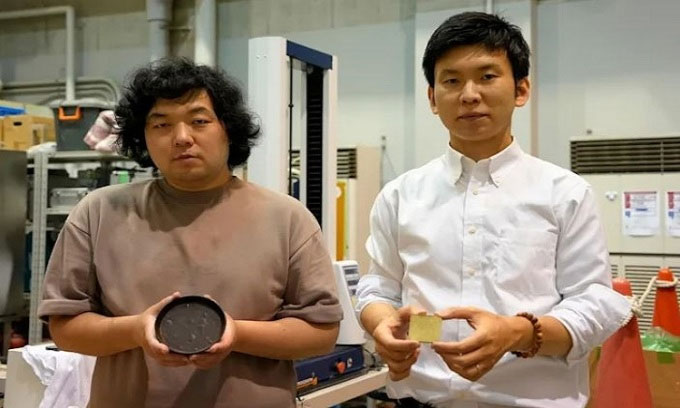Technology turns food waste into edible cement
Research group Kota Machida and Yuya Sakai at the University of Tokyo have developed technology to convert food waste into edible cement for construction purposes.
This is the first process in the world to produce cement entirely from food waste. The team says the tensile strength of the product is nearly four times greater than that of conventional concrete. Machida and Sakai hope to contribute to reducing the impact of global warming and the problem of food waste that emits methane when it decomposes in landfills.

Researchers Yuya Sakai (right) and Kota Machida hold products made from edible cement.
Sakai, associate professor of Industrial Science, developed the technology while researching sustainable materials that could replace cement-based concrete. Cement production accounts for 8% of the world's carbon dioxide emissions. Initially, Sakai found a method to create concrete by placing wood pulp under high temperature when compressed. The 3-step process of drying, crushing and compacting is accomplished with simple mixers and compactors.
Along with student Machida, Sakai decided to experiment with leftovers. Previous experiments using leftovers to make cement required mixing the resin to make the materials stick together. After months of failures, the team found they could make cement bind by adjusting temperature and pressure. According to Sakai, the biggest challenge is that each type of leftovers requires different levels of temperature and pressure.
Other experiments using construction waste have mainly focused on using coffee grounds or bio-waste ash as fillers in plain concrete. Sakai and Machida have successfully produced cement from tea leaves, orange and onion peels, coffee grounds, cabbage and even lunch leftovers. They adjust the additive to different spices and find that the color and taste of the cement can be quite appealing. To be edible, the material needs to be broken down into small pieces and boiled. In order to make the cement waterproof and prevent rodents from coming to eat, the team applied a layer of lacquer to the material.
Leftover food is a big problem in Japan in particular and the world in general. Japan emitted about 5.7 million tons of food waste in 2019 and the government is aiming to reduce the amount of food waste to 2.7 million tons by 2030. Sakai said the new cement could be used to build houses. edible field in disaster areas. "For example, if food can't be delivered to evacuees in time, they can eat makeshift beds made from cement. Cement from leftovers is reusable and biodegradable, so can buried in the ground if not needed anymore. We hope this type of cement will replace plastic and cement products that are bad for the environment," Sakai shared.
- The technology turns plastic waste into edible fungus
- Cement holds safe nuclear waste for 100,000 years
- Breakthrough ideas for making cement from waste salt
- Green cement
- Mexico invented eco-cement made from glass chips and garbage
- Future food technology
- Utilizing food waste - a new mission of biotechnology
- NASA turns human excrement into food for astronauts
- The formula makes the new type of cement reduce the amount of CO2
- Cement is smart to withstand both bombs
- Future iPhone made from cement?
- Build solid houses from clay
 'Barefoot engineer' invents a pipeless pump
'Barefoot engineer' invents a pipeless pump Process of handling dead pigs due to disease
Process of handling dead pigs due to disease Radiometer
Radiometer Warp Engine: Technology brings us closer to the speed of light
Warp Engine: Technology brings us closer to the speed of light